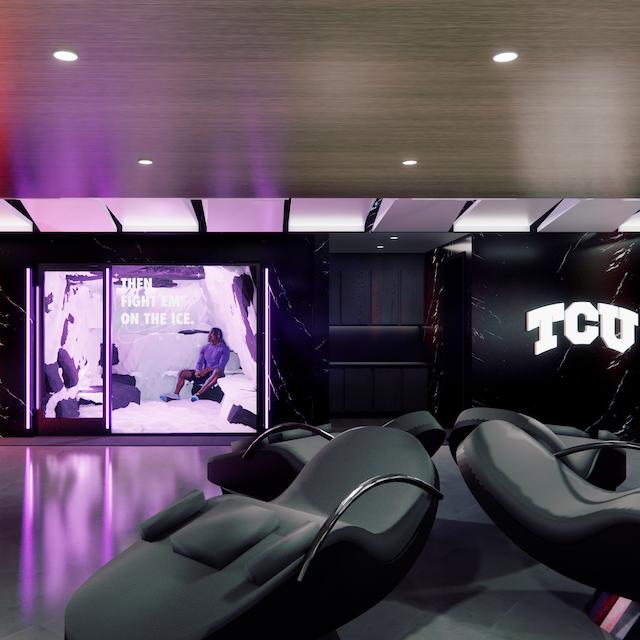
Cold Plunge: TCU Faculty Share the Cold Truth of Cold Therapy
TCU Athletics’ new Simpson Family Restoration and Wellness Center will make TCU the only school in the nation and just the third facility in the United
States to have a dedicated Snow Room. Purple snow, that is. Regarding the use of cold
therapy in athlete care, TCU News spoke with Dr. Jason Mogonye, assistant professor of family medicine at the
Burnett School of Medicine at TCU, and Kristina White, clinical education coordinator
and assistant professor in the graduate athletic training program in Harris College
of Nursing & Health Sciences.
The use of cold therapy has been increasing recently. Can you explain some of the
physical health benefits and, particularly, what those benefits are to athletes?
JM: Participating in athletics and being an active person creates damage to our bodies.
Whether that’s the muscles, tendons, ligaments or bones, your body must find a way
to repair that. The idea behind cold therapy, cold plunges and cryotherapy is that
it can help reduce inflammation or at least reduce bad inflammation in a way that
helps the body repair itself a little quicker, better and more efficiently.
KW: The most compelling evidence for cryotherapy, or cold therapy, supports its use immediately
following acute injury. Exposing injured tissue to cold treats inflammation by lowering
the tissue’s temperature, inducing vasoconstriction and limiting overall secondary
injury. Cold therapies, including cold water immersion and cryochambers, have been
used for many years for physical recovery. 
We understand there are also some mental health benefits. Can you speak to those as
well?
JM: People who cold plunge or do cryotherapy say they tend to sleep better, which is one
of the most important things we can do for recovery and goes hand in hand with nutrition.
If something helps somebody sleep better, they’re going to recover better and have
better mental health. People who don’t sleep well tend to have more depression, be
more anxious and lose focus more easily.
KW: Introducing the body to cold puts the body through “positive stress.” The environment
takes our body out of its comfort zone, a nod to the way of life of our hunter-gatherer
ancestors. In addition to sleep quality, other mental health benefits include improved
mood, stress relief and a healthier sense of self.
It seems the most common cold therapy is the “cold plunge” you mentioned. Is there
a difference between “cold therapy” and “cold plunge”?
JM: Not really. It’s just a matter of the medium in which you're getting cold. The cold
plunge means I’m getting in ice-cold water. Cold therapy doesn't necessarily have
to be water, but it can be. There are also cryo saunas that use liquid nitrogen to
hyper-cool a room or a box. But what medium you’re in doesn't really matter. It's
just the effect of the ice cold.

KW: The concept of “snow rooms” is brand new to the cryotherapy landscape, but developers
explain similar recovery benefits such as promoting respiratory health, boosting metabolism,
increasing energy output, improved blood circulation and alleviating muscle soreness.
While the effects of a snow room experience on the body are comparable, it is touted
as a much more pleasant experience than an ice-cold shower or cold plunge.
How does the specific therapy of a snow room work?
JM: Basically, it’s just a big cold room. The reason it’s large is because we have a lot
of student-athletes who are going to require the benefits of cold therapy. It’s easier
if we can do more than one at a time, which is what’s been happening with our cryosauna
in the past. A large cold room provides the cold environment and does the job for
the cryotherapy or the cold therapy.
KW: The snow room offers a softer, dry cold (14-23 degrees Fahrenheit) that is much more
tolerable – maybe even enjoyable! Immediately after entering the room, the body begins
reacting with narrowing peripheral blood vessels and blood flow centralizing to the
body’s vital organs.
Athletic strain and injuries are serious business. Not only are you talking about
someone’s college experience, but also the potential impact of scholarship, future
plans, etc. What can you tell us about developments in athletic conditioning and treatment
and why therapy like this is an important investment?
JM: From a sports medicine and sports performance standpoint, the No. 1 goal is to take
care of the athlete, whether that’s physically, mentally or emotionally. People get
injured, but with strength and conditioning, good nutrition and reinforcing mental
health, we try to prevent as many injuries as possible. When an athlete is down or
not competing, there’s a risk of other problems, like depression. If we can prevent
that by helping them recover from everyday aches and pains so that they’re not becoming
more injured, that’s a worthwhile investment. Big injuries that may require surgery
or more time away are not going to necessarily be fixed by this. The goal is to help
the body recover from the everyday workload that is required of a student-athlete.
KW: Student-athletes have always been challenged to balance the sport, academic, social
and personal demands of college life. With the introduction and growth of NIL funding
and opportunities, an athlete’s performance (and health status) is more important
than ever. Athletic trainers, strength and conditioning coaches and sport coaches
will utilize the updated facilities and cutting-edge therapies to ensure athletes
are physically, physiologically and psychologically ready for optimal athletic performance.
Is there anything else we should know?
JM: The plan is for it to actually snow in the room, which is probably more of an environmental
thing and entertaining to watch! Snow falling is relaxing, going back to the mental
health benefit. It’s not going to be like a blizzard, but simply a cool feature to
help the athlete relax, which is part of the recovery process. The fact that it’s
purple snow just makes it better!
KW: Although there is no added therapeutic effect from coloring the snow, at TCU we know
that everything is better when it’s purple! (And we can expect nothing but the best
for our Horned Frog athletes!)
